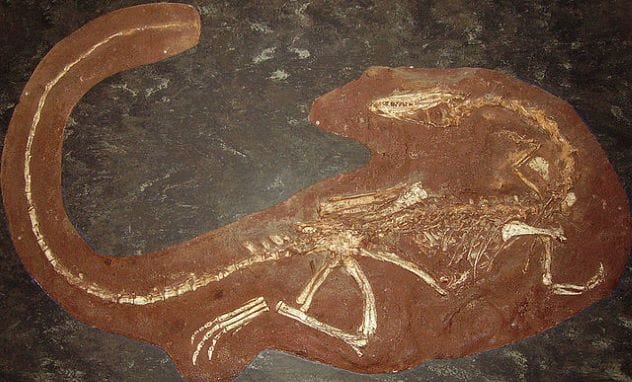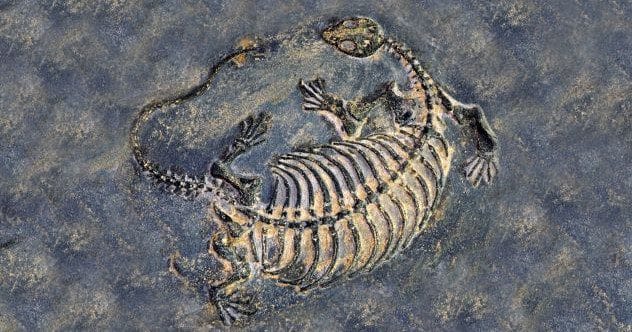Paleontologists dedicate their lives to studying ancient life, but sometimes, the most significant discoveries happen by sheer accident. Imagine stumbling upon a fossil that rewrites history during a casual walk! This list highlights ten of the most fantastic fossil finds made completely by chance.
Mammoth Fossils Found During Construction Work
In 2016, construction workers near Mexico City unearthed a 14,000-year-old mammoth while installing a drainpipe. The scattered bones suggested the animal had been butchered. Then, in 2019, residents of Puebla found a mammoth tusk alongside ancient wolf and camel remains. The mystery of their shared location was solved by the discovery of ancient weapons, indicating humans likely killed the animals and left them to decompose. In 2020, the spotlight shone on archaeologists when about 200 mammoth skeletons were found beneath a construction site earmarked for an airport. Giant mammoth traps were also found at the location.[1]
Giant Millipede Fossil Found on a Beach
Imagine an 8-foot-long millipede! These gigantic bugs roamed the earth 100 million years before dinosaurs. In 2021, scientists in the UK discovered the fossilized remains of a massive millipede at Howick Bay, Northumberland, England. They were there studying the geology, when they stumbled upon a boulder that had broken loose from a cliff. Upon approaching the rock, they saw the fossil inside the crack. This Arthropleura fossil was only the third of its kind ever discovered and the first in England.[2]
200 Million-Year-Old Dinosaur Bone Found in Rubble

In August 2021, geology professor Mark McMenamin was walking on the University of Massachusetts Amherst campus. He passed a group of contruction workers and asked if he could take some loose rocks to add to his wife’s garden. When he inspected the stones at home, Professor McMenamin noticed that the rough texture of one of the rocks resembled that of a fossil. He tested it and discovered that the rock contained the elbow bone of a neotheropod. Neotheropods lived during the Early Jurassic Period, characterized by their sharp teeth and hollow bones. McMenamin believes this dinosaur fed on freshwater fish and may have lived in the water. They existed before the T. Rex and were the largest predatory dinosaurs of their time.[3]
Boy Trips Over Stegomastodon Fossil
In 2017, 9-year-old Jude Sparks tripped over what turned out to be a significant fossil find. While hiking with his family in New Mexico, Jude stumbled over something he thought was cow bones. His parents realized it was something special and contacted a professor, who identified it as a Stegomastodon tusk. The family started a fundraiser to excavate the site, and the entire skull of the Stegomastodon was uncovered. Stegomastodons are related to woolly mammoths and were ancestors of today’s elephants. They were likely hunted by early humans, and their fossils are rarely found intact.[4]
85,000-Year-Old Ancient Whale Skeleton Found in Jungle
A group of scientists visiting a Taiwanese jungle in 2022 stumbled upon an ancient whale skeleton. They found whale ribs sticking up from the ground. The excavation revealed over 70% of an ancient blue whale’s remains, including its jawbone, tailbone, and skull pieces. Eight scientists carried the bones on stretchers for seven hours. This massive fossil, the second largest ever found on the island of Taiwan, was taken to the National Museum of Nature Science for preservation.[5]
Norway’s Single Dinosaur Fossil Found During Oil Drilling Operation
In 1997, an oil company drilling in the North Sea hit a dinosaur fossil at a depth of 7,401 feet. It was a knucklebone from a Plateosaurus that lived during the Triassic Period, nearly 210 million years ago. This is the deepest dinosaur fossil find ever. The Plateosaurus likely washed out to sea by a tsunami. This knucklebone is the only dinosaur fragment found in Norway, but experts believe more fossils could be discovered on the island of Spitsbergen.[6]
Remarkably Well-Preserved Fossil Found During Mining Operations
In 2011, an excavator operator in Alberta, Canada, found a diamond pattern on a piece of rubble. It turned out to be the most well-preserved armored dinosaur fossil ever found, and the oldest fossil discovered in Alberta. The fossil was a new species of nodosaur. Paleontologists found that the dinosaur died after eating a meal of ferns and other plants. The digested food was as well preserved as the creature itself, changing previous assumptions about the diet of plant-eating dinosaurs. The stomach also contained a small amount of charcoal.[7]
Man Finds 82-Foot Dinosaur in His Yard
In 2017, a man overseeing construction on his property in Pombal, Portugal, noticed bone fragments sticking out of the ground. Scientists began an excavation and discovered that the bones belonged to an 82-foot-long sauropod that lived around 160 million years ago. The uncovered vertebrae and ribs included ribs that were almost 10 feet long, the largest sauropod ribs ever discovered in Europe.[8]
Teacher Finds Fossil Older than Dinosaur Fossils
Lisa St. Coeur Cormier, a high school teacher, was walking her dog along Cape Egmont Beach in Prince Edward Island in August 2022 when she saw what looked like a tree root emerging from the sand. It was a rib cage connected to a spine and a skull. Scientists concluded that the bones belonged to a reptile that lived during the Carboniferous Period nearly 300 million years ago, making it older than dinosaur fossils. The fossil is still being studied.[9]
Hadrosaur Fossil Found with Skin Still Attached
In 2021, biologist Teri Kaskie was visiting Dinosaur Provincial Park in Alberta when she spotted a fossilized skeleton protruding from a rock. It was a Hadrosaur fossil so well preserved that some of its skin still covered the bones. Experts confirmed that such a well-preserved Hadrosaur fossil is rare. The skeleton may be intact underneath the rock, and the exposed part is the tail and right hind foot. The dinosaur likely died after a riverbank collapsed on it. Hadrosaurs were large, duck-billed, plant-eating dinosaurs that roamed North America and Asia during the Late Cretaceous Period 77 million years ago.[10]
These accidental fossil discoveries remind us that incredible finds can happen when we least expect them. Whether it’s construction workers, hikers, or teachers, anyone can stumble upon a piece of history. These chance encounters have significantly contributed to our understanding of ancient life.
What do you think about these accidental discoveries? Share your thoughts or any similar stories in the comments below!










